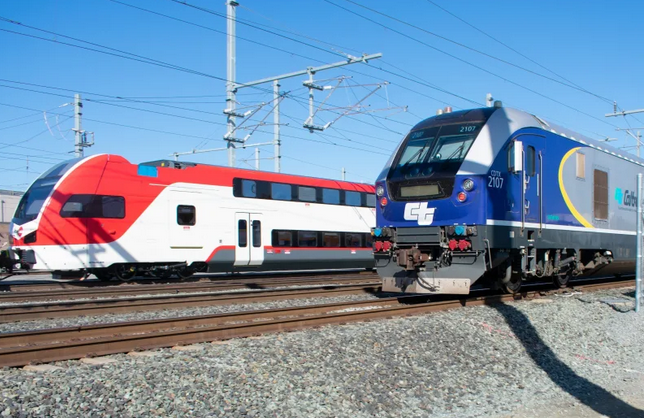Note: GJEL Accident Attorneys regularly sponsors coverage on Streetsblog San Francisco and Streetsblog California. Unless noted in the story, GJEL Accident Attorneys is not consulted for the content or editorial direction of the sponsored content.
Advocates last week celebrated the launch of the Clipper BayPass, basically a student pass that will be accepted on nearly all of the Bay Area's transit systems. It's the first step towards true fare integration of the many separate transit agencies.
But Amtrak isn't part of the pilot.
Amtrak's Capitol Corridor (CC), which runs from San Jose to the Sacramento area, shares a few miles of track with Caltrain. Both stop at or run through San Jose, College Park, and Santa Clara stations. But the two use completely different ticketing systems and fare structures. The CC, which is funded by the state, also stops in Fremont, Hayward, Oakland Coliseum, Jack London Square, Emeryville, Berkeley, Richmond, and Martinez in the Bay Area.
The CC has transfer points with BART and a ferry connection at Jack London Square. In fact, with year-to-date CC ridership of over half a million, Amtrak carries more people and does more to address Bay Area mobility than, for example, Napa's VINE bus system or even the SMART train in the North Bay, which are both participating in BayPass.
So why can't the CCs accept BayPass along the section from San Jose to Martinez?
The simple answer is because BayPass will be added to Clipper cards, which Amtrak can't accept. "We're intercity rail and we're required to have a list of passengers that are on the train; that's Federal Railroad Administration regulations," explained Robert Padgette, Managing Director of the Capitol Corridor Joint Powers Authority, which oversees its operations. And Clipper does not have the capability to track passengers.
The CCs instead have conductors patrolling the passenger cars scanning RF codes from phones and paper tickets, using an antiquated Amtrak fare-collection system. Because of that, "we're extremely limited in our ability to be flexible," said Padgette.
"This illuminates the divide between the Metropolitan Transportation Commission and the statewide California Integrated Travel Project program," explained Ian Griffiths of Seamless Bay Area.
The Cal-ITP program, which will modernize Amtrak's fare media within California while still adhering to Federal regulations, also seeks to integrate and rationalize fares with connecting services. "My agency is the project sponsor, so we're going to start a pilot in February, and we'll sign up like 200 people for it," said Padgette.
This pilot will allow riders to use app-based payment systems and credit cards to pay for passage directly, sans tickets. The goal is to incorporate European-style features such as fare capping, so that if someone rides a Capitol Corridor train enough times in a given period it will automatically convert them to a monthly pass. "We're trying to make it a lot easier to take our trains," said Padgette.
The Cal-ITP pilot is going to look at allowing through-tickets with other services, such as Sacramento's light-rail system. Integrating with transit in the Bay Area is also on the agenda. "I'd like for my customers to be able to easily transfer to any system that connects to our system," said Padgette. That should become technologically easier to pull off as MTC rolls out a more capable Clipper 2.0 in the Bay Area as part of its Clipper modernization plan.
"A potentially good fit - that could include MTC's nine-county operators and megaregional operators, Capitol Corridor, Santa Cruz, etc. - would be a multi-agency fare capping tier that supports a broad geography. Fare capping is easily compatible with the open-loop architecture that CalITP uses," explained Green Caltrain's Adina Levin.
Both Levin and Padgette seemed optimistic that it will eventually be possible to knit Amtrak's Bay Area service into Clipper 2.0 in an integrated, rationale fare system, despite Amtrak missing out on BayPass. But Griffiths remains skeptical about Amtrak getting on board. "Cal-ITP is developing payment standards statewide, whereas MTC is heavily invested in Clipper. Ultimately both need to work together."






